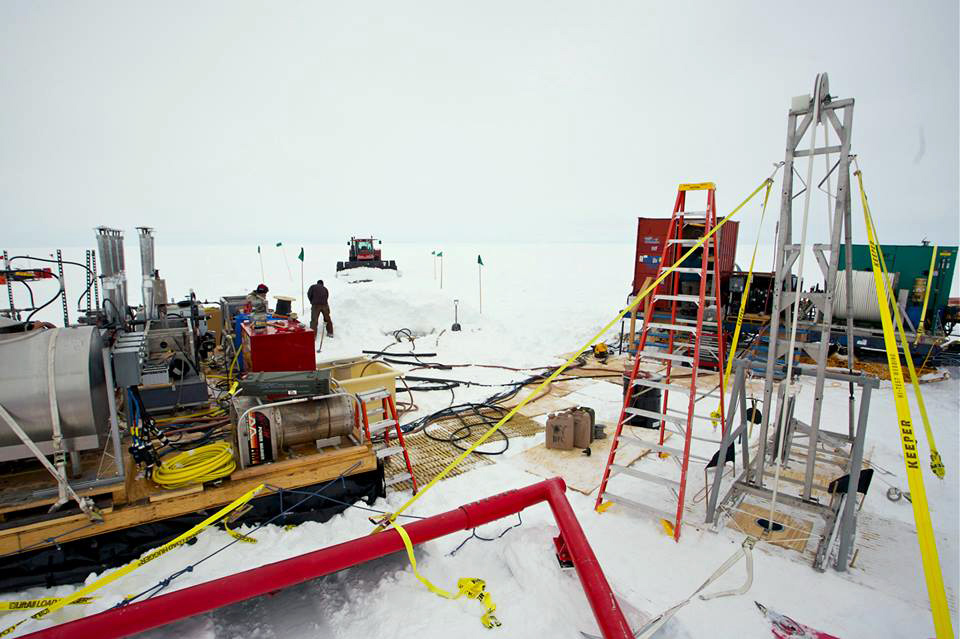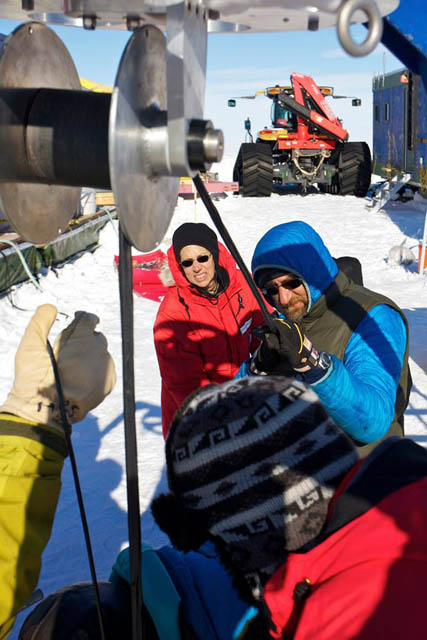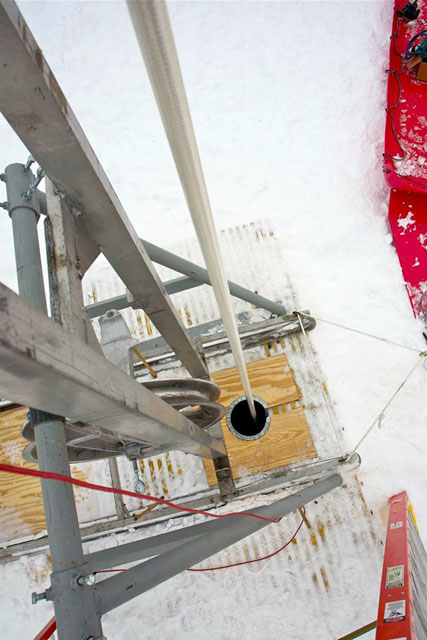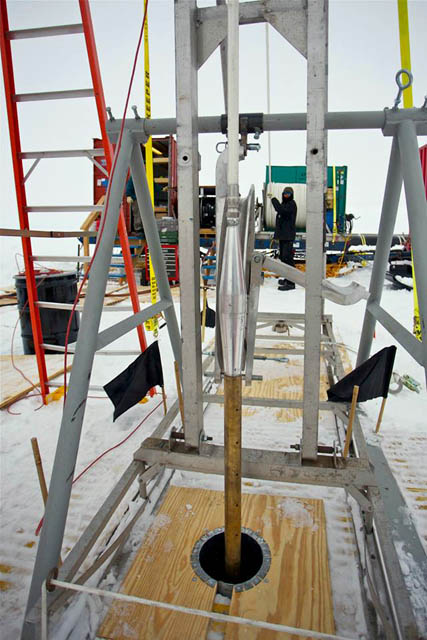Roving aroundTeam uses drill platform to install instruments for studying unique glacier movementPosted August 22, 2014
Breaking News
National Science Foundation press release:
800 meters beneath Antarctic Ice Sheet, subglacial lake holds viable microbial ecosystems
In January 2013, U.S. researchers in Antarctica made history by drilling through hundreds of meters of ice into a subglacial lake where they found evidence of microbial life. The National Science Foundation Instead, a team with the Whillans Ice Stream Subglacial Access Research Drilling (WISSARD) “The Whillans Ice Stream has really weird behavior, it moves in stick-slip events,” explained Grace Barcheck In 2003, glaciologists first reported in the journal Science that Whillans Ice Stream exhibited what they called “stick-slip” behavior. Instead of steady movement, the ice stream jerks forward like clockwork twice a day, kicked awake by tidal motion at the grounding line where the ice leaves the bedrock and floats. The movement produces a burst of seismic waves, each half-meter jump forward equivalent to a magnitude-7 earthquake. A series of other papers – mainly using data from continuously operating seismometers and GPS instruments at the ice surface – about the behavior of the ice stream have followed. An ice stream is a region within the ice sheet that moves faster than the surrounding ice. [See previous article — Finding the sticky spot: Stagnating glacier offers array of puzzles for glaciologists to solve.] Now scientists with the WISSARD project are trying to get their ear as close to the ground as possible below the ice to understand more about the factors involved in the stick-slip motion. The clockwork movement likely plays a role in the subglacial hydrology that periodically drains and fills the shallow lake that shares the same name with the ice stream. Slawek Tulaczyk It appears from previous research by other polar scientists – Sridhar Anandakrishnan at Penn State Seismometers near the bottom of each borehole, in tandem with a surface array of such instruments, will allow the scientists to use the wave energy from earthquakes and even the motion at the bottom of the ice sheet to study the initiation points. The borehole seismometers, in particular, offer greater sensitivity to the activity at the bedrock. “If we are really close, we have a better signal,” Barcheck noted. The research has implications outside of glaciology. “It’s also of interest to seismology as well,” noted Tulaczyk, an associate professor of Earth and Planetary Sciences Tulaczyk explained that most earthquakes, particularly the larger, more violent ones, are brief, infrequent and unpredictable. The stick-slip events last about 20 minutes at a time. “Making observations at high frequency at the right place and the right time is unusual in seismology. We have this reliable earthquake that comes back every 12 hours,” he said. “I think ultimately Whillans Ice Stream will tell us something about how faults break.” In addition to the seismic instruments, temperature sensors in the boreholes will provide insight into how much geothermal heat may be affecting the ice at the bottom. Measurements during the major 2012-13 WISSARD campaign found an unusually high amount of geothermal flux, according to Tulaczyk. 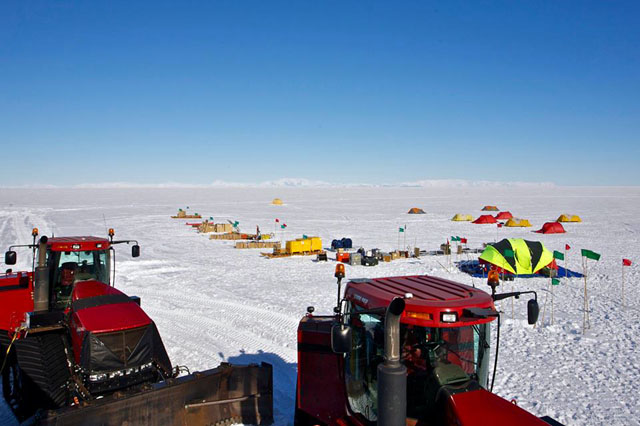
Photo Credit: Chad Carpenter/WISSARD
The WISSARD field camp, with the tractors used to haul the drill platform in the foreground.
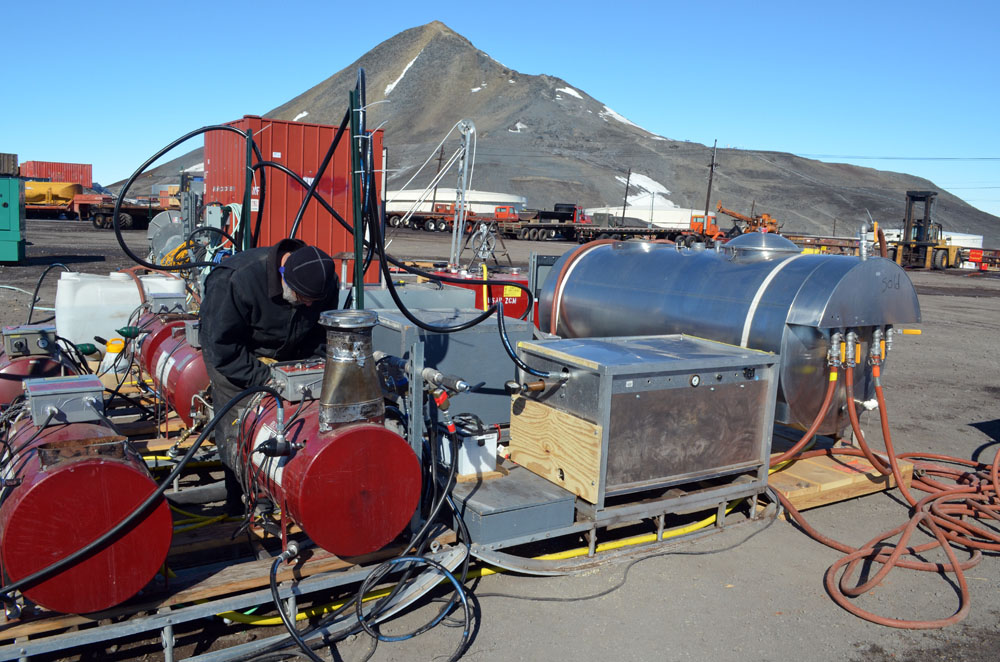
Photo Credit: Peter Rejcek
WISSARD lead driller Dennis Duling works on the WISSARD drill before leaving McMurdo Station.
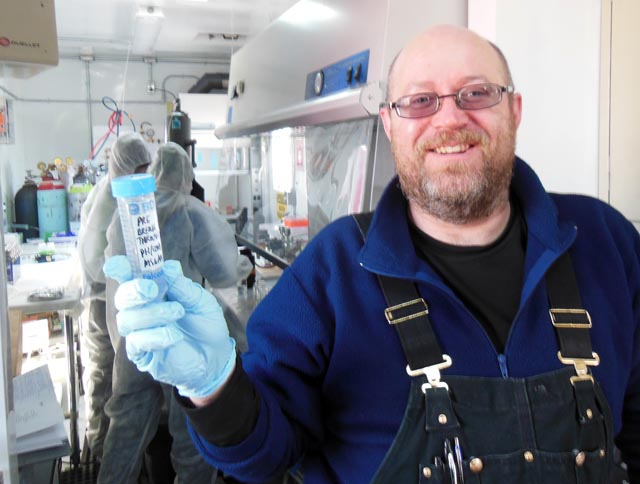
Photo Credit: Reed Scherer/Antarctic Photo Library
Scientist Mark Skidmore holds up a vial of the first sample recovered from subglacial Lake Whillans in January. The team will return to Antarctic in 2014-15 to collect more samples under the ice.
“We really don’t know if it’s melting or freezing [at the bottom],” he said. “We don’t know much about subglacial geothermal flux because there are so few measurements.” Finally, strings of inclinometers in each borehole will measure the deformation and shearing of the ice as it undergoes stress when it moves. Last year’s project had a much smaller logistical footprint than the 2012-13 expedition, which employed a large hot-water drill system that required all instrumentation to be sterilized to avoid contaminating the subglacial lake. There was no such restriction for the roving drill since each borehole stopped short of the bedrock and sediment below the ice. “There was no drama on this one. It was the easiest one I’ve done,” said Dennis Duling, the leader of the drill team from the University of Nebraska-Lincoln The roving drill – basically, several high-pressure washers with heaters attached to them and a thousand meters of hose – was cobbled together from previous drilling systems. Parts were mainly scavenged from the Kamb-Engelhardt Hot Water Drill “It really is a Frankenstein drill,” Duling said. While Whillans is one of several ice streams that drain from West Antarctica to the Ross Ice Shelf “This place is special and provides a window on how ice interacts with the bed without having the fuzzy filter of viscous ice motion,” Tulaczyk said. The WISSARD project will return to full strength for the 2014-15 season, with scientists planning to drill through the ice near the grounding zone where the Ross ice Shelf floats away from the grounded West Antarctic Ice Sheet. Researchers are interested in learning more about the biology, glaciology, hydrology and geology of this subglacial system in a little-explored area of Antarctica. “It’s like planetary exploration. It’s high risk, [but high reward],” Tulaczyk said. NSF-funded research in this article: Susan Schwartz, Andrew Fisher and Slawek Tulaczyk, University of California Santa Cruz, Award No. 1043784 |



For USAP Participants |
For The Public |
For Researchers and EducatorsContact UsU.S. National Science FoundationOffice of Polar Programs Geosciences Directorate 2415 Eisenhower Avenue, Suite W7100 Alexandria, VA 22314 Sign up for the NSF Office of Polar Programs newsletter and events. Feedback Form |

